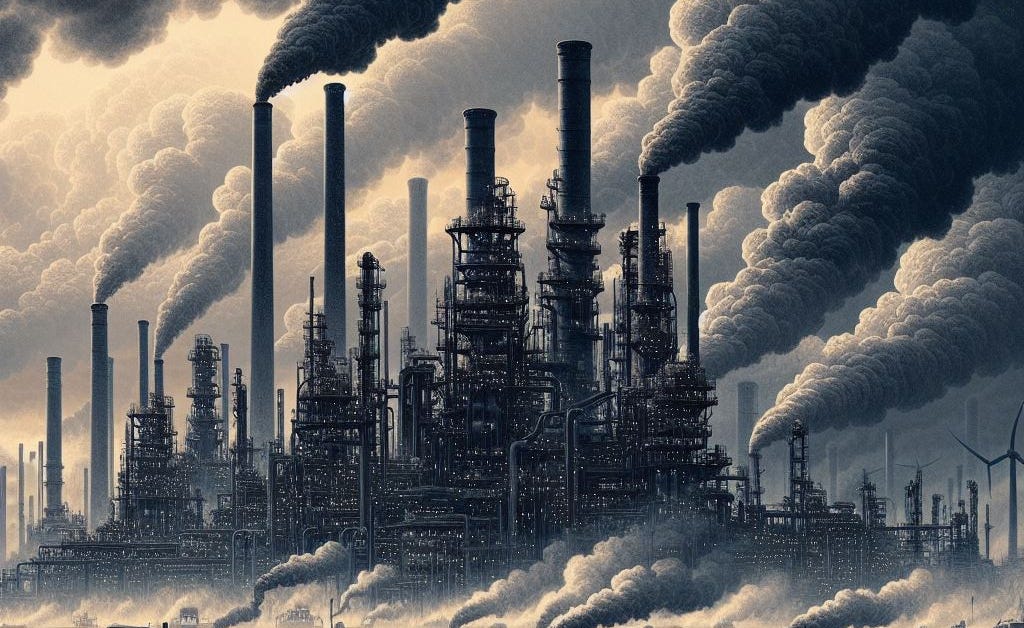Cheerleaders of the Apocalypse
This week saw Big Oil's chiefs decrying the "failure" of the energy transition. Do not be fooled.
This is Edition #1 of The Climate Laundry. Please subscribe if you’d like to see more.
“We should abandon the fantasy of phasing out oil and gas.”
That was Aramco’s CEO Amin H. Nasser, speaking at the CERAWeek conference in Houston this week. CERAweek is the Comicon of the fossil fuel industry, where oil execs and their fawning fanbase congregate for mutual rubbing and to tell each other it’s all going great. Climate activists are not welcome, but pronouncements of the sort Nasser delivered receive rapturous, quasi-erotic murmuring from the faithful.
“The current transition strategy is visibly failing on most fronts,” Nasser proclaimed, his words lauded as “welcome news” in a weirdly sycophantic Fortune article. The Saudi executive couched his admonitions about the folly of decarbonization in a potpourri of concern trolling about its “affordability” for the little people. The upshot of all this? We’ll all need to keep sucking down hydrocarbons, more or less forever.
Of course, downplaying the transition as a “nice-to-have” rather than a necessary condition for a liveable planet, is itself a strategy. When a powerful lobby seeds the narrative that something is failing, it’s intended as a self-fulfilling prophecy. Think of it as a cartoonishly evil version of manifesting your dreams.
After all, fossil fuel industry CEOs see the transition as a zero-sum game—which it probably should be. Deep down, even oil executives understand that a future for humanity depends on all of us burning less of the product that they got fat selling. And it is now abundantly clear to all that renewables and electrification are, both in the economic and planetary survival sense, the only game in town. But it is no exaggeration to say that Aramco, Exxon and friends regard the world as theirs by divine right: they built it, and they’ll be damned if anyone is wresting it from their clutches. Quite apart from anything else, there’s more cash to be squeezed out of the darned thang.
So, in the wake of Nasser’s comments, men like Darren Woods of Exxon chimed in to agree, saying that what the world needs is stuff like carbon capture and storage (CCS), which entails burning more fossil fuels but capturing their emissions and sticking them where the sun don’t shine (that is to say, back into the lithosphere). CCS is essentially the methadone of the oil industry, except methadone can actually help addicts move away from heroin, while CCS keeps us hooked to the product. That’s because, unlike methadone, CCS doesn’t actually exist—at least, not yet. This was admitted by Chevron’s own CCS guy, Chris Powers, who was wheeled out at CERAweek to say the firm is pinning its hopes on CCS, but “it’s going to take decades” to get anywhere with it.
Lest we forget, organized civilization does not have decades to wean itself off fossil fuels.
But the cynicism of Nasser’s speech goes further and deeper than merely selling more of his own product: in declaring the failure of the transition, Nasser was trumpeting what he views as an achievement. Faithful hacks at Fortune and Yahoo Finance didn’t notice, but anyone who’s been paying attention understands that oil industry executives like Nasser have spent decades, and million of dollars, doing everything in their power to prevent the energy transition from succeeding.
That’s not speculation: we have the receipts. Just this month, Dario Kenner at the University of Sussex delivered a mountain of documentary evidence showing that the American Petroleum Institute (API) and FuelsEurope spent half a century lobbying governments to not support clean energy policies and innovation, while sucking up billions for themselves. In 2022, the U.S. oil lobby spent $124 million greasing palms in Washington, D.C. to keep politicians onside—and it’s money well spent: per the IMF, that same year, fossil fuel firms received $760 billion in U.S. government support. The extent to which the oil and gas lobby is in bed with governments has led Oil Change International to call for a Separation of Oil and State agreement. But as long as Exxon, Chevron et al sell governments on the promise of CCS, they get to keep pumping their product, and benefiting from $7 trillion a year in direct and indirect subsidies.
All this is to say that the oil industry’s CERAweek posturing needs to be seen in its proper context. It is part of a sector-wide necropolitical reconfiguration: if the Big Oil of the 2010s was all about cuddly, phoney environmentalism and making measly investments in renewables for PR clout, 2020s Big Oil is the industry going based and redpilled. This makeover has seen firms like Shell “focus on their core business,” weaken their emissions targets, with CEO Wael Sawan largely abandoning any pretence of developing the firm’s renewable and decarbonization concerns, stating that “cutting oil and gas is not healthy.” The BP of 2014 probably wouldn’t have pushed a massive promotional campaign for its latest oil rig all over social media, but the BP of 2024 doesn’t give a single F. Elsewhere, Chevron, Exxon and the rest have declared that they have now, unabashedly, chosen cash over climate.
Rather than attempting to placate the concerns and feelings of Western politicians, some of whom still pay quaint lip service to acting in the best interests of the public, today’s oil industry is out and proud. It has no interest in the rarer, more thoughtful brand of investor that would like their children to inherit a functioning homeworld. Rather, the oil CEO of 2024 is committed to Doing The Meme—to wit: “Yes, we destroyed the planet, but for a beautiful moment in time we created a lot of value for shareholders.” A key component of this effort is telling us, as Amin Nasser just did, that no, a better world is not possible.
That’s what they’re selling. It is our duty as a species to not buy it.
I have a new podcast! Or rather, the great Paolo Bosonin and myself have a new podcast, with Paolo presenting. ON THIN ICE brings together legends of the adventuring world with sustainability founders and researchers to get our heads around the innovations and trade-offs that might (or might not) get us to an equitable space within planetary boundaries. It’s on Apple, Spotify, YouTube and more.
My latest Forbes piece on wind turbines and American house prices suggests that NIMBYism, at least when it comes to wind turbines, isn’t really much of a thing in the U.S. The fear of NIMBYism, however, appears to have a far greater effect.
For the love of all that is holy, please take a look at my piece on the EDF/Google/New Zealand/SpaceX/Harvard MethaneSAT project, for which I secured several hard-to-get interviewees.
Grist’s Taylar Dawn Stagner has a vital piece of reportage on the construction of a copper mine in Arizona on land sacred to several Indigenous nations. It’s a reminder that the materials required for electrification also have serious cultural, social and environmental costs, and that climate justice necessitates taking these into account. (Grist)
It was exciting to see Ada Ventures, an explicitly diversity- and inclusion-forward London-based VC, hitting $80 million on the final close of its second fund. Far from putting LPs off, putting DEI first has attracted them in droves. It’s almost as though leaders are becoming increasingly aware that, given the right approach, diversity equals strength. (TechCrunch)
File under exasperating: in the U.S., Ars reports that from Florida to Arizona, state legislators are looking to ban meat grown from animal cells in labs, citing a “war on our ranching”. Ars notes that agriculture accounts for 11% of the US’s greenhouse gas emissions - with a quarter of that coming from cattle. Alternative proteins are a crucial nut to crack in developing sustainable food systems. (Ars Technica)
In this info-packed, featurey (probably not a word) blog post on CollabFund, Ashika Kalra and Emily Stoler show that, while the global population and its demands have increased, “our ability to extract and use materials failed to meet these demands.” The authors detail how sustainable material innovations, from synthetic biology to design for degradation can, and indeed must, revolutionize every step of the production cycle. (CollabFund)
Find me on Bluesky, Threads and—if you really have to—Twitter.








